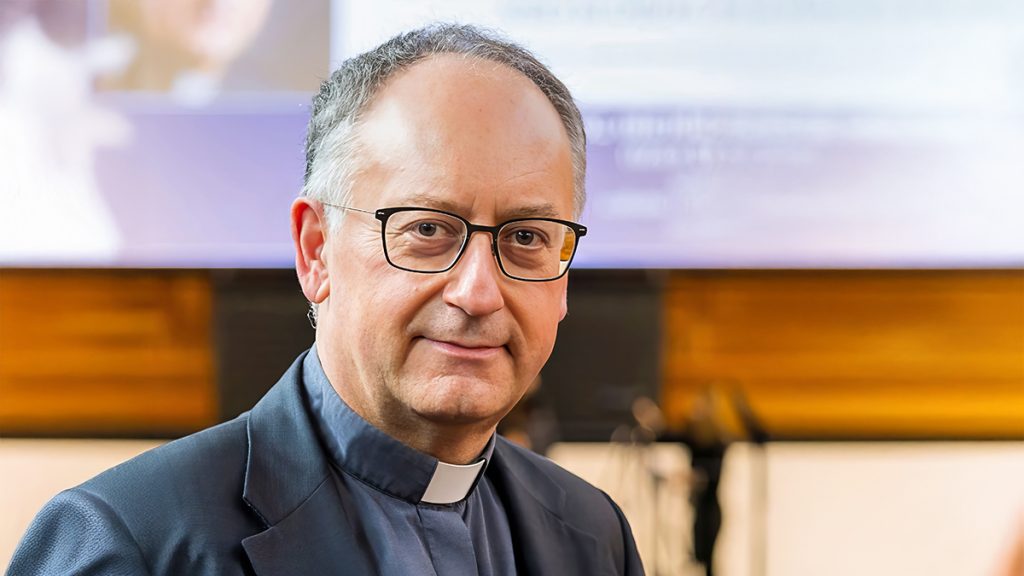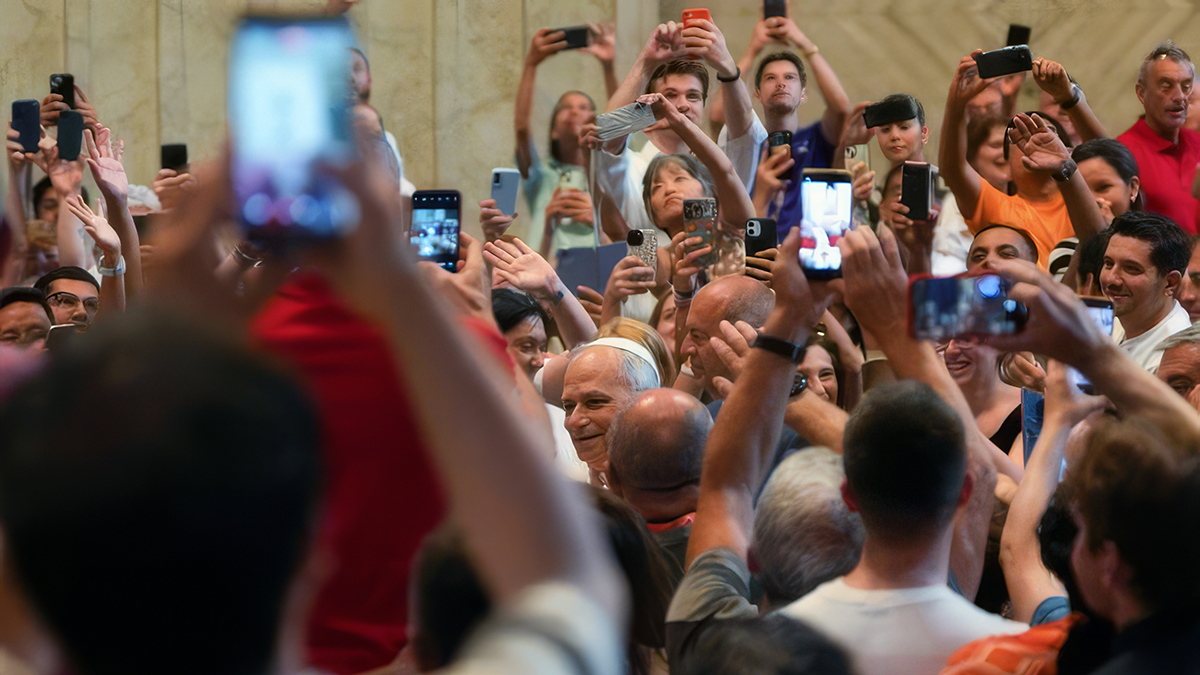Beneath the baroque dome of the Sheldonian Theatre, Oxford, where Arts and Sciences receive, from above, the Truth that dispels ignorance, two men, Biz Stone and Evan Sharp, cofounders of Twitter and Pinterest respectively, are talking about God. Or rather, about the sacred.
From scepticism to spiritual searching
The title of the event, Reconnecting with the Sacred in a Technology-Driven World, might have drawn a smirk from a rationalist of the last century, for whom technology was the ultimate proof of the eclipse of the divine.
And yet the hall was packed with students, young people raised on social networks and the cloud, all listening intently. No longer as distracted spectators, but as pilgrims searching for orientation.
Tech as habitat, not just a tool
The sacred, far from evaporating, has migrated elsewhere: into apps, forums, the invisible architecture of data.
Technology is no longer just a tool; it has become a habitat. A mental, cultural, even spiritual context. It’s not enough to use it to transmit a message; one has to understand it, interpret it, discern what happens to the soul as it passes through the machine.
Faith, AI, and the danger of simulacra
For centuries, people assumed that progress would drain humanity’s religious sources dry. Instead, the opposite has happened. Religiosity has not vanished; it has been reformulated.
In Kyoto, a robot named Mindar delivers Buddhist sermons; in Germany, a Lutheran service was led by a chatbot; in Lucerne, Switzerland, a “digital Jesus” speaks in a hundred languages.
These experiments are both fascinating and unsettling. What does it mean to entrust the mediation of the sacred to artificial intelligence? Can a machine console, forgive, or accompany? Or are these merely simulacra of religiosity, spiritual avatars stripped of mystery?
The soul cannot be coded
The questions are not marginal. If prayer becomes just an output generated by code, rather than a cry rising from within, faith risks dissolving into white noise.
Spirituality, in every authentic tradition, rests on relationship—on irreducible otherness. It cannot be compressed into code or programmed as an interface.
In a flash-driven world,
what matters isn’t what glows,
but what burns.
Faith is not performative;
it is guiding, unsettling, listening.
In the age of artificial intelligence,
it’s not content that saves us
it’s communion.
The web as a real and relational space
And yet religions cannot avoid the encounter.
“The digital environment is not a parallel world or purely virtual,” Pope Benedict XVI wrote as early as 2013, “but part of the daily experience of many people, especially the young.”
This was a conceptual turning point: the web is not an elsewhere, but a real relational environment inhabited by feelings, loneliness, wounds, and hopes.
A mystique of encounter, not escape
The Gospel message—like every spiritual word—does not play out outside the network, but within it.
Pope Francis put it with striking clarity in Evangelii gaudium:
“Today, when the networks and means of human communication have made unprecedented advances, we sense the challenge of finding and sharing a ‘mystique’ of living together, of mingling and encounter, of embracing and supporting one another, of stepping into this flood tide which, while chaotic, can become a genuine experience of fraternity, a caravan of solidarity, a sacred pilgrimage.”
The network as a theological space
This is why speaking of Christian faith in the digital realm no longer means “using social media well,” as one might use a microphone or a printing press, but recognizing that the web is a theological space, a place where ultimate questions arise.
From influencer to creator
The network as a place of questions, of meaning. Perhaps this is why, according to recent market analyses, the word influencer is falling out of favor, replaced by creator.
Why? Because mere influence is no longer enough. Companies, media, and culture itself no longer seek only those who shift opinion, but those who create value, who generate stories, visions, and experiences.
A creator is not just someone who “drives traffic.” They generate reality. They bring new imaginaries into the world. They don’t simply spread messages—they shape worldviews.
Creating meaning, not just content
The true divide, then, is not between those with millions of followers and everyone else, but between those who produce content that merely “works” and those who ignite fires of new meaning.
“Have the courage to dream new versions of the world,” Francis told artists.
The exhortation applies equally to those inhabiting digital spaces: not to settle for repeating what has already been said, but to propose narratives capable of opening up the future, safeguarding complexity, resisting the aggressive simplification of platforms.
The Gospel unsettles, it doesn’t trend.
Catholic influencers
risk neutralising their own message
when they trade authenticity for lifestyle appeal.
A true post of faith is one
that sparks fraternity,
not fame.

Metrics cannot measure mystery
Faith, as a living relationship, cannot be reduced to performance metrics. It does not arise from an editorial calendar, but from a fire that burns within.
Sometimes even Catholic influencers fall into the trap of thinking a social-media post “works” if it’s muscular, or even sexy in its own way, with the posed appeal of a lifestyle shot.
But there is no Catholic physique du rôle. The point is not to gain attention by being ostentatiously attractive; that only neutralizes the very message one hopes, in good faith, to convey.
A post, a video, a gesture becomes meaningful not because it goes viral, but because it conveys a truth that unsettles its audience.
The challenge is not to build a loyal fanbase but to generate fraternity.
The algorithm as mirror, not window
But there is a more insidious danger: hyper-personalization.
The algorithm shows us only what resembles us, enclosing each of us in a bubble of like-minded opinions. Information becomes a mirror, not a window.
Anyone who thinks differently ceases to be an interlocutor and becomes a threat. In this way, even religious communication can morph into an instrument of exclusion.
Francis, addressing Central American bishops, put it bluntly: “I am concerned that compassion has lost its centrality in the Church. Even Catholic media are losing it. There is stigma, condemnation, malice.”
Without compassion, the Gospel risks becoming unrecognizable.
“Influencer” is out; “creator” is in.
The world is hungry
for meaning, not metrics.
Those shaping digital reality
are no longer just driving traffic
they’re building worldviews.
And that’s where faith
finds its new missionary frontier.

Building dialogue, not Babel
In a similar vein, Pope Leo XIV, in his first address to journalists, urged a move beyond the “tower of Babel” of ideological and factional language.
“Communication is not merely the transmission of information, but the creation of human and digital environments that become spaces for dialogue.”
The challenge is not to build a loyal fanbase but to generate fraternity.
When the algorithm becomes an idol
Meanwhile, as religions wrestle with their language, machines take on an unpredictable role.
A decade ago, Yuval Noah Harari warned that in a world dominated by data, divinity risked being recognized in the processing of data itself. The algorithm as idol. Salvation as output.
A theology to protect the human
The Holy See, in its 2025 document Antiqua et nova, cautioned against a parallel danger: not the divinization of the machine, but the idolatry of the human bowing before its own creation.
What’s needed is a theology capable of preserving the opaque boundaries of the human—neither retreating into fear nor succumbing to fascination with the machine.
A synod on intelligence
We need religious communities capable of reminding us that the human is not a function, and that truth is not an output. Salvation cannot be downloaded with a click.
Religions, all of them, are not called to compete with big data; they are called to safeguard what cannot be measured—to remind us that not everything that counts can be counted.
From this perspective, the task of religions today is a shared one.
I have dreamed—and I choose my words carefully—of an interreligious synod on intelligence, where Christians, Muslims, Buddhists, Jews, Hindus, and others gather to face the questions no algorithm will ever resolve: What is the human? What is suffering? What is hope?
What burns, not what shines
In a culture of artificial lights, flashes, and filters, what transforms is not what shines but what burns.
Not what seduces but what guides. Genuine religious practice is the art of listening for what no machine will ever pronounce.
And it is precisely for this reason that, in the age of artificial intelligence, we still so desperately need faith.

- Antonio Spadaro, SJ, is undersecretary of the Dicastery for Culture and Education of the Holy See. He is a member of the board of directors of Georgetown University and an Ordinary academic of the Pontifical Academy of Fine Arts and Letters of the Virtuosi al Pantheon. He was editor in chief of La Civiltà Cattolica for twelve years.
- Reprinted with permission. Copyright Commonweal Magazine.

